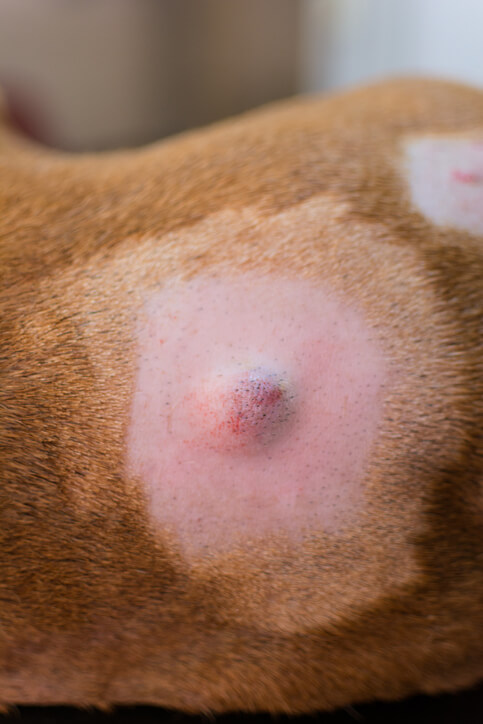If you’re petting your dog and feel a lump, you may feel panic or worry. Your mind may go to the worst-case scenario: cancer. It’s essential to keep in mind that there are many different types of lumps your dog can experience for various reasons. Fortunately, many of these lumps do not pose a serious health risk to your dog.
Although not all lumps are serious, they shouldn’t be ignored. It is always best to contact your veterinarian for a proper diagnosis and treatment. At Animal Medical Center of Streetsboro, we’ve put together a guide to help you understand the different types of lumps on your dog.
What are the Common Types of Lumps on a Dog?
There are a variety of lumps that can appear on your dog’s body, including some that are rare. Common types of lumps include:

- Sebaceous cysts- This is a type of lump that develops due to your dog’s oil glands becoming blocked. They are similar to a pimple on a human, but they can grow much larger. Typically they will go away on their own and won’t require treatment, but it is important to leave them alone and not pop them. Popping them could put your dog at risk of infection.
- Hematomas- This type of lump develops as a raised bruise. They are caused by trauma to your dog’s flesh and may appear to be hard, tender, and swollen. These, much like a cyst, are not life-threatening. Your veterinarian may need to examine the injury that caused the hematoma to make sure no other damage, such as broken bones, has occurred.
- Lipomas- This is one of the most common lumps that dogs experience and is not a growth that you need to worry about. A lipoma is a benign fatty tumor that can appear all over your dog’s body in varying sizes. They tend to become more prevalent as your dog ages.
- Abscesses- This type of lump is caused by an infection and will require prompt treatment by your vet. An abscess is typically hot to the touch and painful for your dog. They do not pose a major health risk if they are treated before the infection can spread. If you suspect your dog has an abscess, be sure to make an appointment as soon as possible to have it treated.
- Cancerous tumors- This type of lump will be harder than a lipoma and won’t be sensitive or hot to the touch. Tumors may also be benign, which won’t put your dog at risk. It is critical to have a biopsy performed to examine the tumor and check if it is cancerous and requires treatment.
Your dog can develop lumps on its body at any age, but older dogs are more likely to develop them due to the risk factors of skin issues or cancer. Lumps like lipomas are often associated with aging dogs, but young dogs can develop these as well.
When Should I Contact My Veterinarian?
If you are unsure what is causing the lump, it is always best to bring your dog in for an exam. If you see pus, redness, swelling, fast growth, an opening, or if your dog is suffering in pain, we recommend that you make an appointment as soon as possible.
You also want to keep an eye on the area where the lump is located. Lumps on the face or paws may need to be surgically removed for your dog’s comfort and mobility. When you visit your veterinarian, you will want to have the following information:
- When the lump appeared or if it appeared suddenly
- Whether the shape, size, or color of the lump has changed
- Whether your dog has been behaving differently, such as not eating or acting lethargic
Whether you can determine the cause of the lump or not, it is always best to consult with your veterinarian to see if the lump needs to be tested and identified.
Have a question about a lump on your dog? Contact the Animal Medical Center of Streetsboro.
If you have any questions or concerns about a lump on your dog, please contact the Animal Medical Center of Streetsboro today to learn more or to schedule an appointment.

